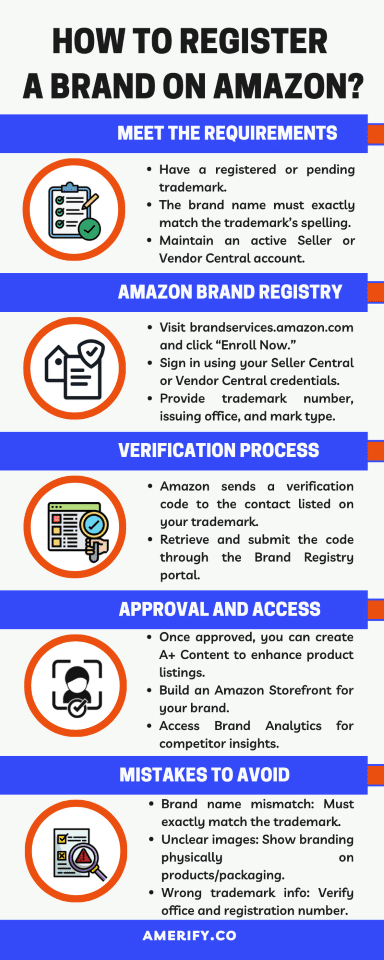Key Takeaways:
- Amazon Brand Registry is a free program that protects your intellectual property and gives you access to advanced brand tools.
- You’ll need an active or pending trademark before you can register your brand.
- Once approved, you gain full control over your listings, brand analytics, A+ Content, and enhanced advertising options.
Why You Should Register Your Brand on Amazon?
Registering your brand isn’t just a formality — it’s a competitive advantage.
Amazon’s Brand Registry gives you the legal and digital tools to:
- Protect your brand from counterfeits or hijackers.
- Control how your products appear and are described.
- Access brand-exclusive features like A+ Content, Amazon Stores, and Sponsored Brand Ads.
- Analyze your performance through Brand Analytics and other insights.
In short, Brand Registry lets you protect what you’ve built and grow with confidence.

Step 1: Meet the Requirements
Before you can register, you’ll need a few essential items ready.
| Requirement | Description |
| Trademark | You must have a registered trademark (or a pending one via Amazon IP Accelerator). Both word marks and design marks (logos) are accepted. |
| Exact Brand Name Match | The brand name you submit must exactly match the name on your trademark — same spelling, punctuation, and capitalization. |
| Amazon Account | You need an active Seller Central or Vendor Central account to start the process. |
| Product or Packaging Images | Images showing your brand name or logo permanently affixed to the product or its packaging — not photoshopped or digitally added. |
| Company Details | Legal business name, address, and contact info that matches your Seller Account. |
Pro Tip: If you don’t yet have a trademark, Amazon’s IP Accelerator connects you with vetted law firms who can file one quickly and make you eligible for Brand Registry while your trademark is still pending.
Step 2: Log In to Amazon Brand Registry
- Go to brandservices.amazon.com and click “Enroll Now.”
- Sign in using your existing Seller Central or Vendor Central credentials.
- If it’s your first time, you’ll be prompted to select “Enroll a New Brand.”
Step 3: Submit Your Brand Information
Here’s what Amazon will ask for during the application process:
- Brand Name: Enter it exactly as it appears on your trademark certificate.
- Trademark Details: Include the trademark registration number and the issuing office (e.g., USPTO for the United States).
- Trademark Type: Specify whether it’s a word mark or design/logo mark.
- Logo Upload (if applicable): Provide your official logo file if it’s part of the trademark.
- Product Images: Upload clear photos showing your brand name or logo printed or engraved on the product or packaging.
- Categories & ASINs: Select the product categories your brand sells in and provide at least one ASIN that uses your brand name.
If Amazon can verify your trademark automatically, the process will move faster. Otherwise, you may be asked to upload additional documentation.
Step 4: Verification Process
Once submitted, Amazon will send a verification code to the contact listed on your trademark registration (often your attorney or trademark holder).
You’ll need to get that code and provide it back through the Brand Registry portal.
After verification, Amazon will review your application. The approval process usually takes 10–14 business days, though it can vary depending on your region or documentation quality.
Step 5: Approval and Access
Once your brand is approved, you’ll receive confirmation via email and gain access to the Brand Registry dashboard.
From there, you can:
- Create A+ Content (Enhanced Brand Content) to improve your listings.
- Build your Amazon Storefront — a customizable mini-website for your brand.
- Access Brand Analytics to see top-performing keywords, shopper insights, and competitor data.
- Run Sponsored Brand Ads and Sponsored Display Ads — exclusive to registered brands.
- Use Report a Violation tools to remove counterfeit or infringing listings.
Common Mistakes to Avoid
| Mistake | Why It Happens | How to Fix It |
| Brand name mismatch | Even a minor spacing or capitalization difference between trademark and Amazon brand name can trigger rejection. | Copy and paste your brand name exactly as listed in your trademark registration. |
| Images don’t show branding clearly | Amazon needs proof that your branding is physically on the product or packaging. | Use clear, high-resolution product photos showing printed or engraved branding. |
| Incorrect trademark type or office | Choosing the wrong trademark office or entering an incorrect number causes delays. | Double-check your registration number and select the correct office (e.g. USPTO, EUIPO). |
| Verification code not submitted | The trademark contact misses Amazon’s verification email. | Notify your trademark contact or attorney to expect Amazon’s message and respond promptly. |
Step 6: Use Brand Registry Tools to Grow
Once your brand is live, make full use of what you’ve unlocked.
- A+ Content: Improve conversion rates with premium visuals, comparison charts, and storytelling.
- Brand Store: Showcase all your products in one cohesive, branded shopping experience.
- Brand Analytics: Access keyword and market trend data to improve your SEO and ad targeting.
- Project Zero / Transparency: Protect your brand from counterfeit listings.
- Amazon Vine: Get verified reviews for new products.
All these tools help increase visibility, trust, and conversion rates — especially when combined with optimized listings and advertising.
Step 7: Expand Globally (Optional)
If you sell across multiple Amazon marketplaces, you may need to register your brand in each country where you have a trademark.
For example:
- A U.S. trademark (USPTO) allows you to register on Amazon.com.
- A UK or EU trademark (UKIPO or EUIPO) supports Amazon.co.uk or Amazon.de.
Each marketplace’s Brand Registry portal connects to its local trademark databases, so registering in multiple regions ensures your brand remains protected worldwide.
Final Thoughts
Registering your brand on Amazon is one of the smartest moves you can make as a seller. It builds credibility, strengthens customer trust, and gives you tools that non-registered sellers can’t access.
The process may feel detailed, but once complete, you gain lasting protection and marketing advantages that elevate your brand’s presence across Amazon’s ecosystem.
At Amerify, we recommend getting your trademark early, preparing your product documentation carefully, and following Amazon’s steps precisely.
Because once your brand is registered — your business isn’t just selling products anymore; it’s building a legacy.



